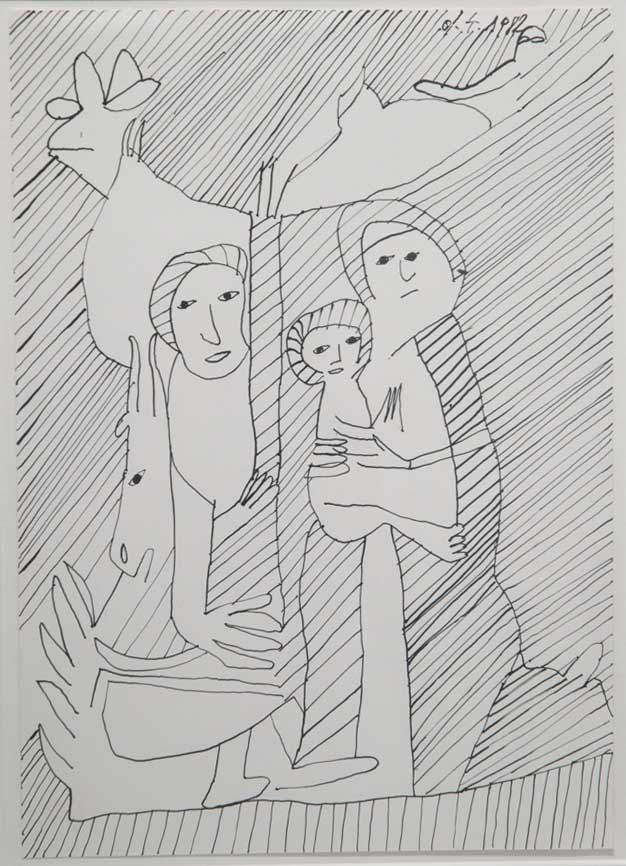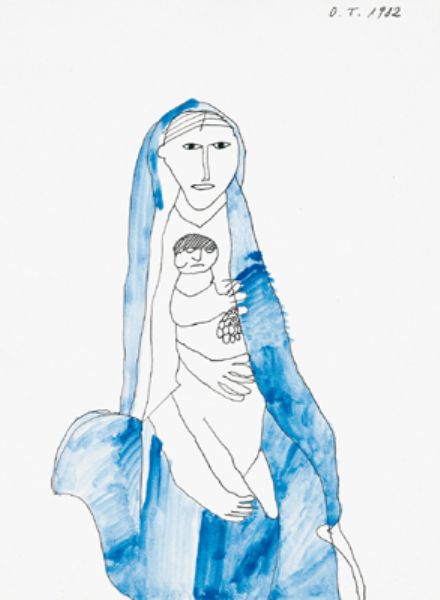The truly unique Austrian artist Oswald Tschirtner’s drawings of the nativity and of Christmas icons offer a simple and beautiful perspective on the holiday season.

The Maria Gugging Psychiatric Clinic, located in Vienna, has a past both dark and beautiful. A psychiatric hospital turned art centre, the clinic was home and workspace to many influential artists who struggled with mental illness, and now operates as a museum and gallery honouring their work. However, Gugging, as it is now known, started off life as a very different place.
It is approximated that over 400 patients were killed at the Gugging Psychiatric Clinic during the Nazi Regime. The Regime’s Euthanasia Programme, a despicable and horrific programme authorised by Hitler himself, took roughly 300,000 lives from 1939 to 1945. Patients deemed ‘incurable’ to doctors were given what was called in official documents a ‘mercy death’, deaths for which the perpetrators were tried for after the war. Unfortunately, the Maria Gugging Psychiatric Clinic was the setting for many of these murders, patients also being transported from the clinic to other areas of mass murder. Rumours had spread by 1940 of the actions of particular doctors within the clinic, though there is little information whether the crimes could be halted.

It was during this time of horror and tragedy that psychiatrist Leo Navratil, who worked at the clinic, began encouraging his patients in artistic endeavours. At first he had his patients produce drawings as part of their therapy, gradually finding that there were a number of talented artists around him. One of these patients was Oswald Tschirtner.
Tschirtner had entered the hospital in 1954 after being diagnosed with schizophrenia following World War 2 in which he was conscripted into the German army. Following stints in various other clinics he was admitted to the facilities at Gugging, where he worked with Navratil. Tschirtner would only draw at Navratil’s request, which he did during psychiatric evaluations.
Tschirtner’s style can be considered extremely simple. He has been praised as representing the human form using only the most minimal of lines and shapes. Tschirtner didn’t raise his pen as he worked but drew in very concise, specific and clean lines. Mostly abstract, Tschirtner’s drawings can only be contextualised through their titles, though they are a joy to look at even for purely aesthetic reasons.

In 1981 Doctor Navratil founded the Centre for Art and Psychotherapy, where he invited patients with artistic endeavours to live and work. In the spirit of this liberation from darkness through pure, unaffected artistic creation, and in the spirit of the holiday season in general, Oswald Tschirtner’s Christmas themed drawings should be appreciated.

Tschirtner’s ‘Nativity’ is a childlike depiction of Jesus, Mary and Joseph. The basic expressions of each individual and Tschirtner’s trademark linework lends a natural, un-glorified feel to the work.

‘Christmas Tree’ is one of Tschirtner’s more complicated pieces, with a texture and depth not often seen in his work. The use of space and the repetition of action are typical of his style, and give the drawing its unique quality.

This untitled work is one of the rarer coloured drawings from Tschirtner. As a devout Catholic man, Tschirtner was often encouraged by Navratil with themes from the Bible for him to portray, which he did with enthusiasm and a pure artistic intention.
Subscribe to FIB’s Weekly Alchemy Report for your weekly dose of music, fashion and pop culture news!







